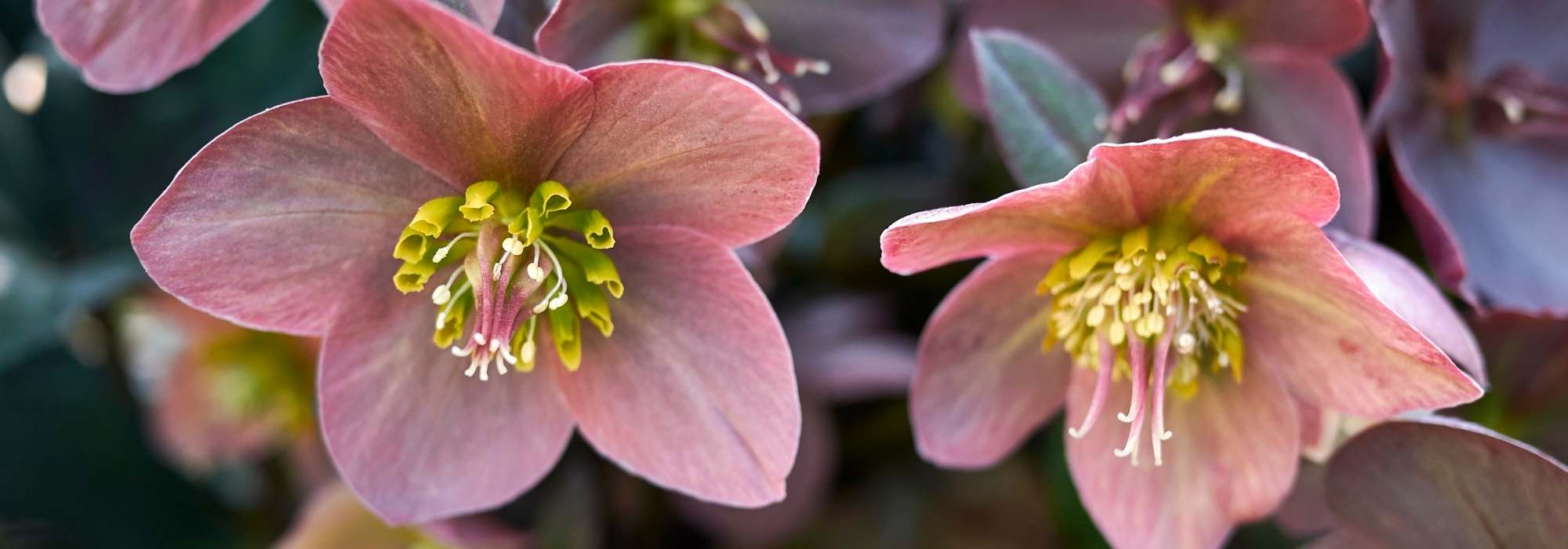
10 single-flowered hellebores
Magical hellebores for wintertime
Contents
Elegant to a fault, single-flowered hellebores effortlessly take centre stage in winter. Many species naturally display corollas often composed of five petaloid sepals, with light-coloured stamens at their heart. This simplicity in flowering is matched only by the charm exuded by these hellebores, whether it be the classic Christmas Rose or the oriental hellebores resulting from hybridization, offering a wide range of colours.
Always beautiful alongside other hellebores, they create sumptuous, evergreen, and colourful carpets for many months in the challenging, shaded areas of gardens. All are hardy, and some even tolerate full sun. Here are some of the most ornamental single-flowered hellebores.
Helleborus niger
This is THE Christmas Rose, classic and timeless, perhaps the most popular due to its early flowering which allows you to enjoy one of the first blooms of the year by the end of December. Native to Central and Southern Europe, its flat white flowers have golden anthers. They measure between 5 and 8 cm in diameter, while the dark green, matte foliage remains supple. Known for its delicate cultivation, it is certainly slower growing than other species, and is one of those plants for which you will choose the location carefully, as it does not like to be moved.
Place your Helleborus niger in the garden alongside delicate spring flowers such as wood anemones, evergreen foliage like Carex, a Pinus Mugo ‘Green Column’, and a Cornus mas ‘Jolico’ with its lovely yellow winter flowers.

Helleborus niger, Cornus mas ‘Jolico’, Carex flaca and white heather
Read also
Hellebores: planting, growingHelleborus orientalis ‘Rose guttatus’
How can you resist this speckled cultivar? The Oriental hellebore ‘Rose guttatus’, also known as ‘Pink Spotted’, features lovely single flowers in a shade of pink ranging from light to deeper tones at its heart, speckled with small purple dots, while the stamens remain a very pale green. With beautiful proportions, it stands about 40 cm tall, and you can plant it like other species of hellebores in partial shade or full shade, in fresh, well-drained soil. Its long flowering period extending into early spring and its evergreen foliage make it one of the most attractive hellebores for romantic gardens, countryside settings, or charming winter balconies and terraces.
Give it a delicate setting in cream, bluish, or pink to purple tones: ‘Pink Spotted’ looks stunning alongside the concurrent flowering of a Viburnum bodnantense, surrounded by a wide carpet of Ophiopogons and early blue touches of early muscaris. A purple viburnum-tin would also be a perfect companion for it.
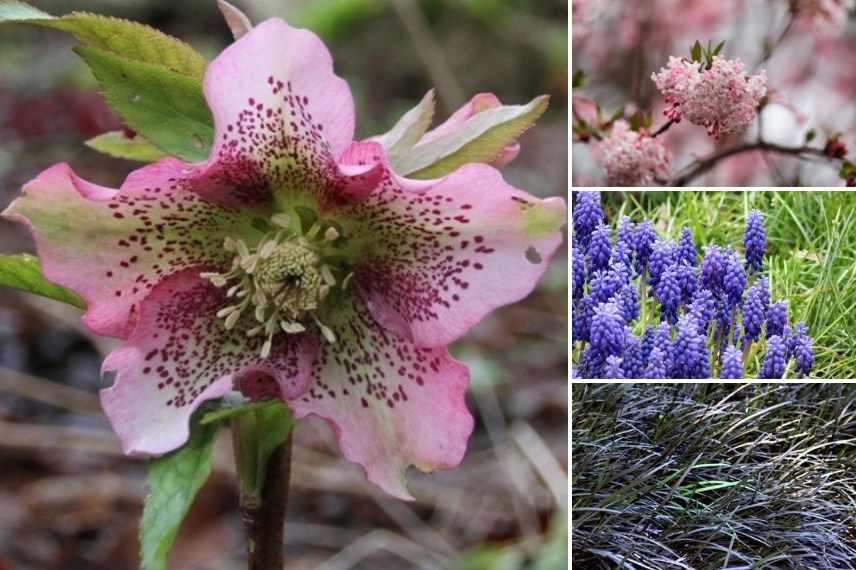
Helleborus oriental ‘Rose Guttatus’, Viburnum bodnantense, Muscaris armeniacum and Ophiopogon planiscapus ‘Nigrescens’
Discover other Helleborus - Hellebore
View all →Available in 0 sizes
Available in 0 sizes
Available in 1 sizes
Available in 2 sizes
Available in 2 sizes
Available in 2 sizes
Available in 0 sizes
Available in 1 sizes
Available in 1 sizes
Available in 1 sizes
Helleborus sternii
Less well-known than others, the Stern Hellebore is the result of a cross-breeding between Helleborus argutifolius and Helleborus lividus, two Mediterranean species, which allows it to be planted in sunnier spots and even in dry soil. The evergreen leaves are leathery and more or less dentate and marbled, with a bluish-grey green colour, and the always single flowers, jade green with often pinkish backs. This is what makes Helleborus sternii interesting, as the flowers often catch the eye… Depending on the varieties, the flowers can be more or less pink, sometimes turning into a beautiful old rose, almost purplish.
Choose one or more to create a lovely border or a mass in a winter garden. ‘Flame’ with its salmon flowers and the typical cultivar pair wonderfully with Iris reticulata, the slender foliage of a Mahonia ‘Soft Caress’, the cover of Epimediums, and Anemones nemorosa ‘Green Fingers’ in white and green. A trio of birches with white bark is enough to reveal the grace and natural beauty of this very wild-looking hellebore.

Hellebore sternii, Mahonia confusa, Anemone nemorosa ‘Green Fingers’, Epimedium x versicolor ‘Sulphureum’
Read also
7 Anemone centred HelleboresHelleborus foetidus ‘Wester Flisk’
It is impossible not to mention at least one Stinking Hellebore among the hellebores with single flowers, even if their name is not very inviting, as they are interesting for more than one reason: they flower later, ensuring a prolonged display in borders, are of a more generous size, have deeply divided evergreen foliage, and boast one of the most charming green flowerings. They can be planted in any exposure, being less sensitive to sunlight than others, and can also tolerate dry soils like H. argutifolius. ‘Wester Flisk’ ticks all the boxes with its lovely pale green trailing clusters of flowers highlighted by a purple edge, its purple stems and petioles standing out particularly well in winter and showcasing the heavy clusters of flowers, and its bronze-green leaves, which are even more slender and narrow than the species.
Long-lived, Helleborus foetidus ‘Wester Flisk’ pairs well with pink heathers, Bergenia ‘Flirt’ with leaves that redden in the cold, and a green-flowered Japanese quince ‘Kinshiden’ that complements it, along with a red-stemmed dogwood like Cornus alba ‘Sibirica’.
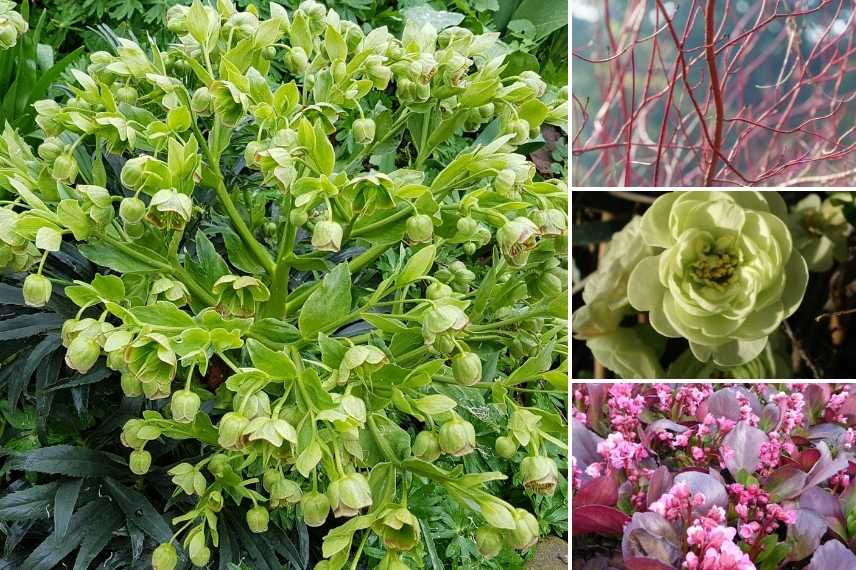
Helleborus foetidus, Cornus alba ‘Sibirica’, Chaenomeles ‘Kinshiden’ and Bergenias ‘Flirt’
Helleborus ericsmithii 'Magic Leaves'
Here is another hellebore that is as appealing for its flowering as for its foliage. The helleborus ‘Magic Leaves’ blooms between January and April, adorned with small white flowers with yellow stamens that will gradually turn to a very graceful greenish white. This is an Helleborus ericsmithii, a hybrid between Helleborus argutifolius and Helleborus niger. From this fortunate union with the Corsican hellebore, it inherits its unique, leathery foliage beautifully veined with cream marbling. Small in stature (about 30 cm tall, with a wider spread of nearly 50 cm), it deserves a spot at the edge of a border.
Pair ‘Magic Leaves’ in the garden or in pots with yellow blooms such as ‘Gipsy Princess’ hyacinths or Gargano crocus that will flower at the same time, along with a blue-tinged dwarf pine, the bleached wood of a Rubus thibetanus, and the evergreen foliage of a variegated spindle ‘Emerald Gaiety’.

Helleborus ericsmithii ‘Magic Leaves’, Euonymus fortunei ‘Emerald Gaiety’, Rubus thibetanus and yellow hyacinths
Helleborus orientalis 'Apricot'
The Oriental hellebore ‘Apricot’ is an ultra-romantic cultivar, a hybrid with a soft, powdery apricot hue to its petals. This Oriental hellebore blooms in February, lasting for several weeks until April, showcasing large single flowers in a charming faded orange. Its foliage is evergreen. Like its little cousin with anemone-like flowers, the colour of its petals can change, becoming much darker, even reaching a purplish orange. Planted like all hellebores in shade or partial shade, it can be used in pots on the balcony, in the garden as a border or in a bed, and as a cut flower to create stunning bouquets.
This apricot hellebore deserves to be paired with warm shades, from coral to purple: feel free to plant it next to a Cornus alba ‘Kesselringii’ with mahogany stems, some purple or wine-veined heucheras, a carpet of Epimediums in orange, and an Edgeworthia chrysantha ‘Red Dragon’ with its sublime coral-orange flowers.
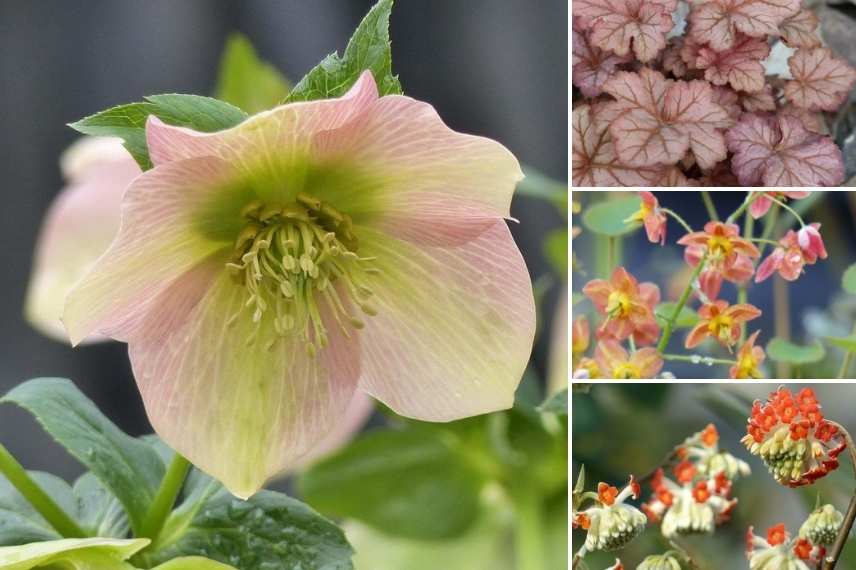
Helleborus orientalis ‘Abricot’, Heuchère Pinot Gris, Epimedium pubigerum ‘Orangekönigin’, Edgeworthia ‘Red Dragon’
Helleborus orientalis 'Peach with Red Centre'
Boasting more intense apricot hues than the ‘Apricot’ hellebore, the Oriental hellebore ‘Peach with Red Centre’ is a small gem of elegance and refinement for gardens! The single flower reveals a peach-pink shade with a contrasting purple centre, set against pale yellow stamens. This colour resembles an old rose, creating a very soft effect. This hellebore, with its old-fashioned charm, will surely appeal to romantic souls! Like others, it requires shade and fresh, even heavy soil. Thriving in a stunning pot from February to April or in the garden under the cover of deciduous trees, it deserves a prominent place in a border.
At the foot of a Cinnamon Maple or a Tibetan Cherry with its sublime winter bark, it will blend its peach tones with the vibrant spring foliage of a Pieris japonica ‘Flaming Silver’ or that of a Nandina domestica ‘Plum Passion’. An essential carpet of bulbous plants like snowdrops will accompany it at the beginning of winter.

Oriental hellebore ‘Peach with Red Centre’, in a border overlooked by the exfoliating bark of an Acer griseum. A Pieris ‘Flaming Silver’ and a carpet of snowdrops complete the scene.
Helleborus orientalis 'Aubergine edged'
This hellebore is so dark that it ranks among the darkest hellebores. ‘Aubergine liseré’ showcases its beautiful personality in gardens with its petals of a very dark red turning to purple, the edge slightly lighter, delicately marking the rosette. Completely hardy like its counterparts, it also prefers shade. The purple colour is perfect for enlivening a pot on the balcony, which can be softened with a lovely heather or pink cyclamen and a variegated ivy. In the garden, it pairs very well with acidic tones, such as those of Helleborus foetidus (‘Wester Flisk’ or ‘Sopron’) or argutifolius, and other purple shades like the Oriental hellebore ‘Double Rouge’, which adds more volume to its inflorescences. A purple wood spurge and a Callicarpa with violet berries are also good companions. It is in mass that this hellebore will make an impression, as its flowers tend to droop like all hellebores.

Oriental hellebore ‘Aubergine liseré’, paired with the purple foliage of Euphorbia amygdaloides ‘Purpurea’, a beautiful Corsican hellebore and the Oriental hellebore ‘Double Rouge’
Helleborus orientalis 'Yellow Anemone Guttatus'
Yellow is one of the most interesting colours in the Hellebore palette, bringing a fresh and vibrant touch to shaded areas. Among the various varieties, the Oriental Hellebore ‘Anemone Jaune Guttatus’ stands out with its petals widely punctuated with purple spots. The flowers are large, up to 7 cm, just like the evergreen leaves. Blooming like most Oriental hellebores between February and April, this beautiful cultivar deserves a pairing of similar tones, soft yellows like a Chimonanthus praecox, or more vibrant and later blooms like a Forsythia, purples with, for example, the wood of a dogwood ‘Kesselringii’ and a gingerbread-coloured Heuchera. It pairs beautifully with other yellow Hellebores such as the lovely Oriental Hellebore ‘Anemone Jaune’, with its frilly centre, apricot Hellebores, or dark red to purple Hellebores.

Oriental Hellebore ‘Jaune Guttatus’, Chimonanthus praecox, Cornus alba ‘Kesselringii’, and Heuchera ‘Timeless Orange’
→ Discover also 7 anemone-flowered Oriental hellebores
Helleborus thibetanus
To conclude this selection of single-flowered Hellebores, we present a rare cultivar, a botanical species from more distant origins, from the Himalayas and China. The Helleborus thibetanus or Tibetan Hellebore is still relatively unknown, yet, despite its deciduous foliage, it deserves our full attention in naturalistic or wild gardens, or for enthusiasts of Hellebores looking to complete a collection. Its flowers are a very delicately pinkish white, stunning, with a greenish heart. The flowering is late, occurring in March, on relatively short stems of about 30 cm. With its botanical aspect, the Tibetan Hellebore is well-suited for creating a flowering mass in a natural area, ideally in woodland. However, it should be reserved for collectors.
Pair it with other single-flowered Hellebores, such as the Helleborus niger, a carpet of Galanthus nivalis, and a cover of Epimediums and evergreen ferns.
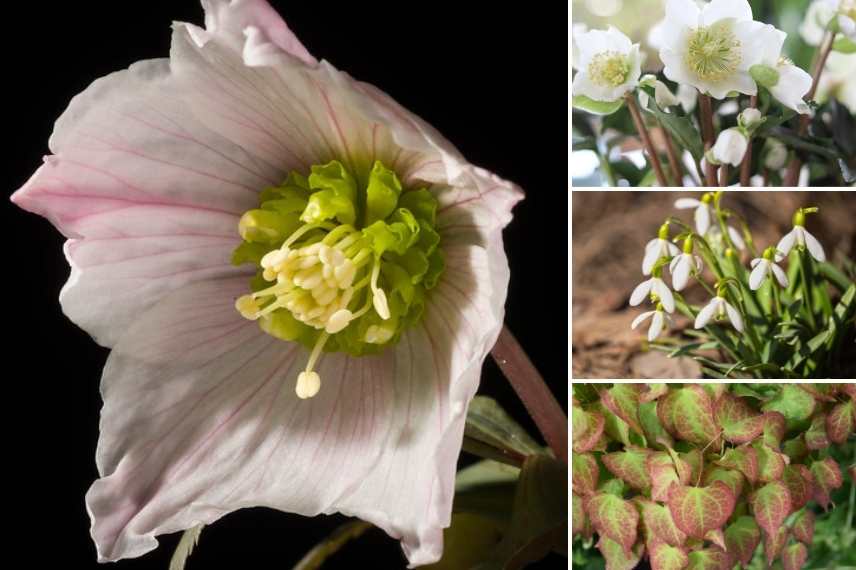
Helleborus thibetanus, Helleborus niger, Galanthus nivalis, and Epimediums
- Subscribe!
- Contents
































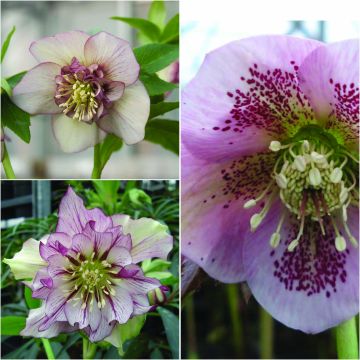
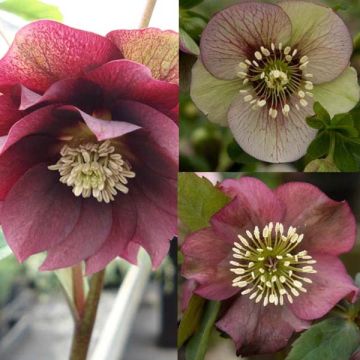
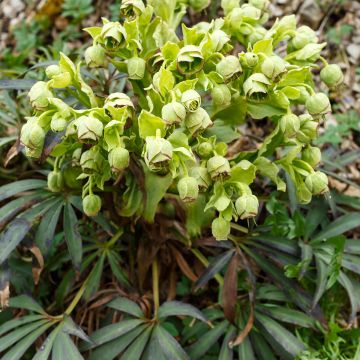
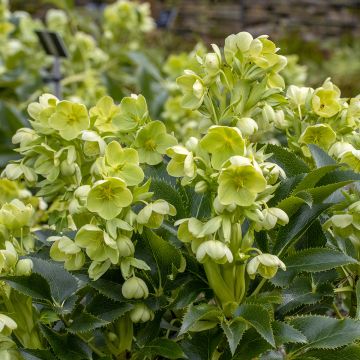
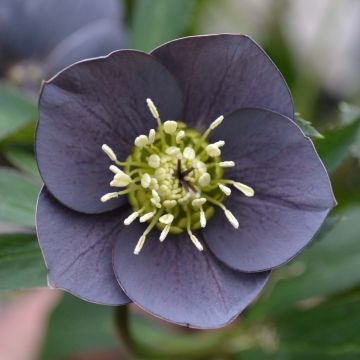
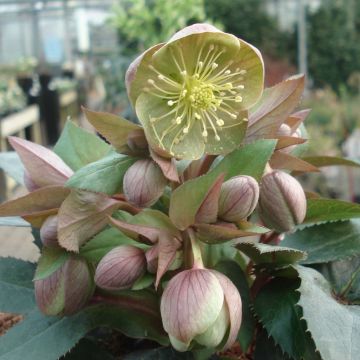

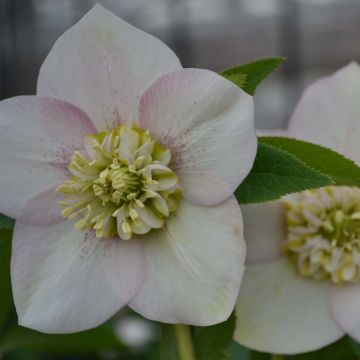
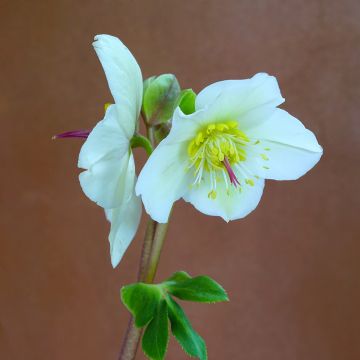
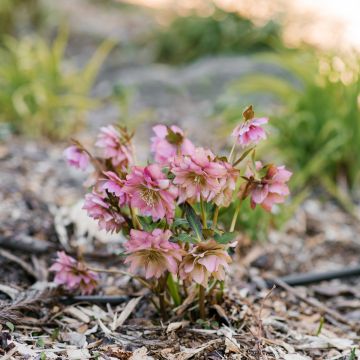
Comments